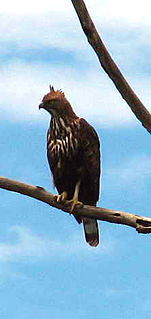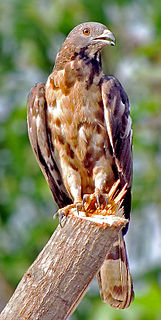 W
WThe typical falconets, Microhierax, are a bird of prey genus in the family Falconidae. They are found in southeast Asia and the smallest members of Falconiformes, averaging about 15 cm (5.9 in) in length and 35 g (1.2 oz) in weight. The smallest members of the genus are the relatively widespread black-thighed falconet, and the white-fronted falconet on the island of Borneo.
 W
WNisaetus is a genus of eagles found mainly in tropical Asia. They were earlier placed within the genus Spizaetus but molecular studies show that the Old World representatives were closer to the genus Ictinaetus than to the New World Spizaetus. They are slender-bodied, medium-sized hawk-eagles with rounded wings, long feathered legs, barred wings, crests and usually adapted to forest habitats.
 W
WSpilornis is a genus of bird of prey in the family Accipitridae. As adults all have dark crowns, and bright yellow eyes and cere. These medium-sized raptors are found in forests of southern Asia and are known as serpent-eagles; an English name shared with two African species from the genera Dryotriorchis and Eutriorchis.
 W
WThe besra, also called the besra sparrowhawk, is a bird of prey in the family Accipitridae.
 W
WThe crested honey buzzard is a bird of prey in the family Accipitridae, which also includes many other diurnal raptors such as kites, eagles, and harriers. This species is also known as the Oriental honey buzzard.
 W
WThe dusky eagle-owl is an owl species in the family Strigidae that is widespread in South and Southeast Asia. It is listed as Least Concern on the IUCN Red List. The species's extent of occurrence is estimated at 9,250,000 km2 (3,570,000 sq mi).
 W
WPallas's fish eagle, also known as Pallas's sea eagle or band-tailed fish eagle, is a large, brownish sea eagle. It breeds in the east Palearctic in Kazakhstan, Russia, Tajikistan, Turkmenistan, Uzbekistan, Mongolia, China, India, Bangladesh, Myanmar and Bhutan. It is listed as Endangered on the IUCN Red List. It is partially migratory, with Central Asian birds wintering among the southern Asian birds in northern India, and also further west to the Persian Gulf.
 W
WThe Philippine eagle, also known as the monkey-eating eagle or great Philippine eagle, is an endangered species of eagle of the family Accipitridae which is endemic to forests in the Philippines. It has brown and white-colored plumage, a shaggy crest, and generally measures 86 to 102 cm in length and weighs 4.04 to 8.0 kg.
 W
WThe white-rumped falcon is a species of bird of prey in the family Falconidae native to Indochina. It is sometimes placed in its own monotypic genus, Neohierax.
 W
WThe eastern marsh harrier is a bird of prey belonging to the marsh harrier group of harriers. It was previously considered to be conspecific with the western marsh harrier but is now usually classified as a separate species. It has two subspecies: C. s. spilonotus in eastern Asia and C. s. spilothorax in New Guinea.
 W
WThe pied harrier is an Asian species of bird of prey in the family Accipitridae. It is migratory, breeding from the Amur valley in eastern Russia and north-eastern China to North Korea. Wintering individuals can be found in a wide area from Pakistan to Philippines. The population consists of approximately 10,000 individuals and the number is thought to be in moderate decline.
 W
WThe black-winged kite, also known as the black-shouldered kite, is a small diurnal bird of prey in the family Accipitridae best known for its habit of hovering over open grasslands in the manner of the much smaller kestrels. This Palearctic and Afrotropical species was sometimes combined with the Australian black-shouldered kite and the white-tailed kite of North and South America which together form a superspecies. This kite is distinctive, with long wings; white, grey and black plumage; and owl-like forward-facing eyes with red irises. The owl-like behaviour is even more pronounced in the letter-winged kite, a nocturnal relative in Australia. Although mainly seen on plains, they are sometimes seen on grassy slopes of hills in the higher elevation regions of Asia. They are not migratory, but show nomadism in response to weather and food availability. They are well adapted to utilize periodic upsurges in rodent populations and can raise multiple broods in a single year unlike most birds of prey. Populations in southern Europe have grown in response to human activities, particularly agriculture and livestock rearing.
 W
WThe Chinese sparrowhawk is a bird of prey in the family Accipitridae which also includes many other diurnal raptors such as eagles, buzzards and harriers. Also called Chinese goshawk or grey frog hawk.
 W
WThe Indian vulture is an Old World vulture native to India, Pakistan and Nepal. It has been listed as Critically Endangered on the IUCN Red List since 2002, as the population severely declined. Indian vultures died of kidney failure caused by diclofenac poisoning. It breeds mainly on hilly crags in central and peninsular India.
 W
WThe slender-billed vulture is an Old World vulture species native to sub-Himalayan regions and Southeast Asia. It is Critically Endangered since 2002 as the population on the Indian subcontinent has declined rapidly.
 W
WThe white-rumped vulture is an Old World vulture native to South and Southeast Asia. It has been listed as Critically Endangered on the IUCN Red List since 2000, as the population severely declined. White-rumped vultures die of kidney failure caused by diclofenac poisoning. In the 1980s, the global population was estimated at several million individuals, and it was thought to be "the most abundant large bird of prey in the world". As of 2016, the global population was estimated at less than 10,000 mature individuals.